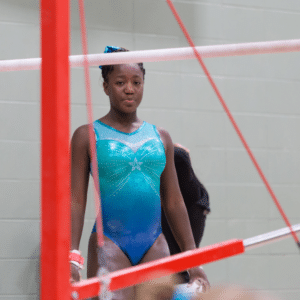
Ever wondered what age does competitive gymnastics start? It’s well known that gymnasts start training at a young age to develop the skills and strength needed to excel in this sport, but when does it become competitive?
In this article, we will discuss the timeline of gymnastics training, competition age requirements and dispel some common myths.
What’s The Best Age For Kids to Start Gymnastics?
Gymnastics can be practiced at any age, but for those wishing to reach an elite or even Olympic level, the age at which they start competing is important.
This is especially true of the most competitive disciplines: artistic and rhythmic.
Female athletes also tend to retire earlier than their male counterparts mainly due to reaching peak physical levels in their late teens and early twenties. This adds pressure for them to start training and competing at an early age in order to have enough time to master all of the skills needed at the top of the sport.
The Early Years: Introduction to Gymnastics
Most gymnasts start practicing gymnastics at a young age. Here at Synergy Gymnastics some start as young as two years old, participating in parent and toddler classes. These classes are usually for children aged two to four and focus on developing the child’s coordination, balance, and body awareness.
From the age of four or five, children often join gymnastics classes on their own. These classes are usually designed for beginner gymnasts and focus on developing basic skills such as rolls, handstands, and cartwheels.
By the age of four or five coaches will be talent-spotting young gymnasts and putting them into competitive pathways depending on their physical and mental attributes.
Not all children will have the necessary attributes needed for selection into a competitive team or pre-team but can remain in non-competitive, recreational classes up to any age at most clubs.
The Foundation Years: Learning the Basics
From the age of six to ten, gymnasts develop their foundation skills. During this time, female artistic gymnasts learn basic skills on all four apparatus – vault, bars, beam, and floor. They also start to develop their strength, flexibility, and coordination.
Gymnasts will start to compete at some point in the age range of six to ten, provided they have been selected to join a competitive program. At this level, they often compete in local and regional competitions.
These competitions at this age should be about enjoyment and experience but often this is overshadowed by the pressure to perform well and become the next rising star. It should be pointed out as well that not all gymnasts go down the competitive route and continue at a recreational level instead.

Development Program: Age Requirements
Competitive gymnastics is divided into different disciplines, such as women’s artistic, men’s artistic, tumbling, rhythmic and trampoline. Each has its specific skill requirements and age restrictions which are all broadly in line with regard to minimum starting ages. For the purpose of this section of the article, we will focus on the most popular and well-known system in the US for women’s artistic: The Development Program formerly the Junior Olympic (JO) program.
The levels are as follows:
- Levels 1 and 2: The first two levels are not usually competed but clubs and coaches use the set requirements as a foundation for teaching basic skills to children as young as three. This will prepare them for competing when they are older.
- Level 3: To compete at level 3 gymnasts must be at least 6 years old. However, some clubs still use level 3 as a non-competitive basis to prepare gymnasts’ basic skills and routines
- Level 4: This is the first compulsory level and gymnasts must be at least 7 years old to compete, even if they have mastered the skills before their 7th birthday.
- Level 5: A compulsory level in which gymnasts must be at least 7 years old to compete.
- Level 6: Minimum age is 7 years old.
- Level 7: Minimum age is 7 years old.
- Level 8: Minimum age is 8 years old.
- Level 9: Minimum age is 8 years old.
- Level 10: Minimum age is 9 years old.
Gymnasts can be older than the minimum age stated but bear in mind that if gymnasts start competing late they will find it harder to catch up.
When do gymnasts start competing in other disciplines?
Age requirements for competitions vary depending on the level of competition. For example, at the local and regional level, gymnasts will start to compete at around five or six years old. However, at the state and national level, there are age restrictions that gymnasts must adhere to.
Xcel
Gymnasts as young as five can begin competing in the Xcel Program. This is an alternative program for Women’s Artistic gymnasts that don’t follow the Developmental Program pathway.
Rhythmic
USAG policy states that rhythmic gymnasts must turn 6 in the year of the competition that they are entering. This would give a possible minimum age of 5.

Men’s Artistic
Competitions are offered from six years upwards in the USAG Men’s Development Program.
Trampoline
Trampoline gymnasts can compete in levels 1 to 4 of the Development Program once they turn six years old.
The Road to Elite Gymnastics
To become an elite gymnast, gymnasts must dedicate themselves to rigorous training and compete at the highest level. Elite gymnasts train for several hours a day, six days a week, and often attend specialized gymnastics schools or training centers.
To qualify for elite gymnastics, gymnasts must meet specific skill and age requirements. Elite gymnasts often start training at four or five years old, and by the age of six or seven, they are expected to compete regularly.
Competing at the Elite Level
Elite gymnasts compete at national and international competitions, such as the Olympics, World Championships, and Pan American Games. These competitions are highly competitive and require years of dedication and hard work.
Female gymnasts can be considered for selection as a senior at these major competitions once they turn 16. Somewhat controversially, male gymnasts are only considered seniors once they turn 18.
There are calls for the age requirement for female gymnasts to be raised in line with male gymnasts to ease the pressure on young teenage girls to meet the strict requirements currently needed.
To compete at the international level, gymnasts must qualify through national competitions and meet specific skill and age requirements. At the international level, gymnasts compete against the best in the world, and the competition is fierce.
Physical and Mental Preparation for Competitions
Competing in gymnastics requires both physical and mental preparation. Gymnasts must have strong bodies to perform the required skills, but they must also have mental toughness to handle the pressure of competition.
Physical preparation includes developing strength, flexibility, and endurance. Mental preparation involves developing coping strategies for competition stress, such as visualization, breathing techniques, and positive self-talk.
Common Injuries in Gymnastics
Gymnastics is a high-impact sport that puts a lot of stress on the body. Common injuries in gymnastics include ankle and wrist sprains, muscle strains, and stress fractures. Gymnasts are also at risk of developing overuse injuries, such as tendinitis and bursitis.
To prevent injuries, gymnasts must train smartly and use proper techniques. They must also take care of their bodies by getting enough rest and nutrition.
Conclusion
Gymnastics is a sport that requires dedication, hard work, and discipline. Most gymnasts that eventually take part in the Olympics were competing regularly by the age of six or seven years old.
Competitive gymnastics is divided into different levels, each with specific age and skill requirements so there will be some variations. Elite gymnastics requires years of dedication and hard work and involves competing at the highest level against the best gymnasts in the world.
To compete in gymnastics, gymnasts must develop strong bodies and mental toughness. They must also take care of their bodies to prevent injuries.
FAQs
What is the minimum age to start practicing gymnastics?
Children can start practicing gymnastics as young as two years old.
When do gymnasts start competing in sanctioned events?
In the United States, gymnasts must be at least six years old to compete in sanctioned events.
What are the age requirements for competitive gymnastics?
Age requirements for competitive gymnastics vary depending on the level of competition. For Level 1 and Level 2 in the USAG Development Program, there are no age restrictions, but for Levels 3-10, there are minimum age requirements.
What are some common injuries in gymnastics?
Common injuries in gymnastics include ankle and wrist sprains, muscle strains and stress fractures. Gymnasts are also at risk of developing overuse injuries, such as tendinitis and bursitis.
What is elite gymnastics?
Elite gymnastics is the highest level of gymnastics competition, where gymnasts compete at the national and international level. Gymnasts become elite once they have passed Level 10.
- How to Do a Back Handspring: Complete Step-by-Step GuideLearning how to do a back handspring is an exciting milestone for any gymnast. It builds confidence, agility, and forms the foundation for advanced tumbling… Read more: How to Do a Back Handspring: Complete Step-by-Step Guide
- How To Get Over a Mental Block In Gymnastics: A Complete GuideGymnastics is a sport that requires not only physical strength and skill but also mental strength. When a gymnast feels like they cannot attempt a… Read more: How To Get Over a Mental Block In Gymnastics: A Complete Guide
- The Best Leotard for Girls in 2025: What to Look ForFinding an ideal leotard for girls isn’t just about picking a dazzling design that sparkles (although it does help!). The leotard has to fit perfectly,… Read more: The Best Leotard for Girls in 2025: What to Look For
- The Best Gymnastics Shorts (Our Top Picks)The best gymnastics shorts are designed to be worn over the top of a leotard providing additional coverage around the upper legs, whilst allowing gymnasts… Read more: The Best Gymnastics Shorts (Our Top Picks)
- Decathlon Leotards – Are They Any Good?If you’re in the market for a new leotard, you may be wondering if Decathlon leotards are any good considering the low cost of their… Read more: Decathlon Leotards – Are They Any Good?
- A Complete Guide to Gymnastics Hand RipsAre you tired of dealing with painful gymnastics rips on your hands from training? Look no further – this article offers a comprehensive approach to… Read more: A Complete Guide to Gymnastics Hand Rips






